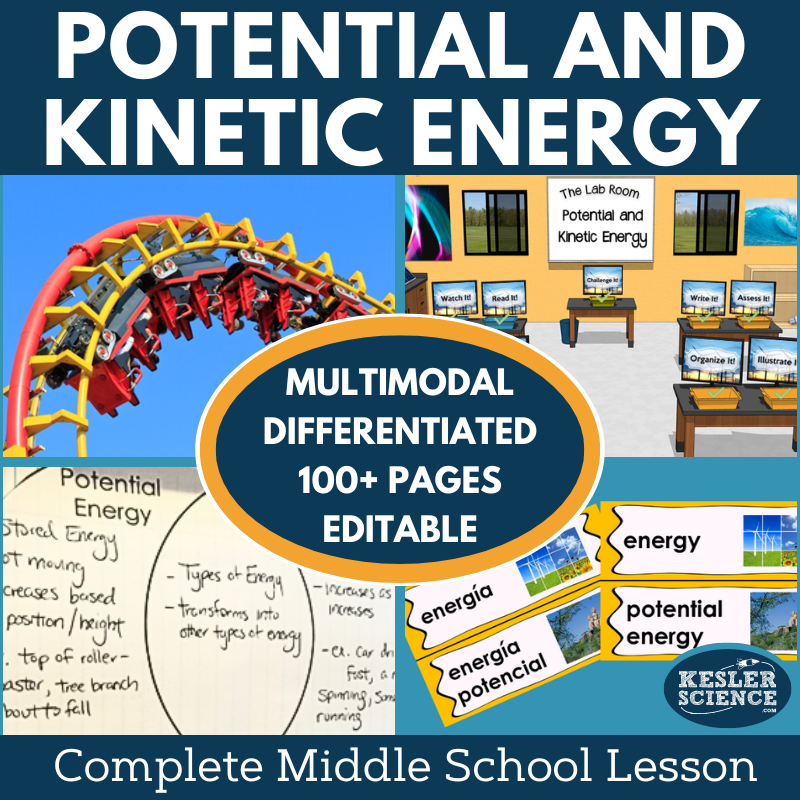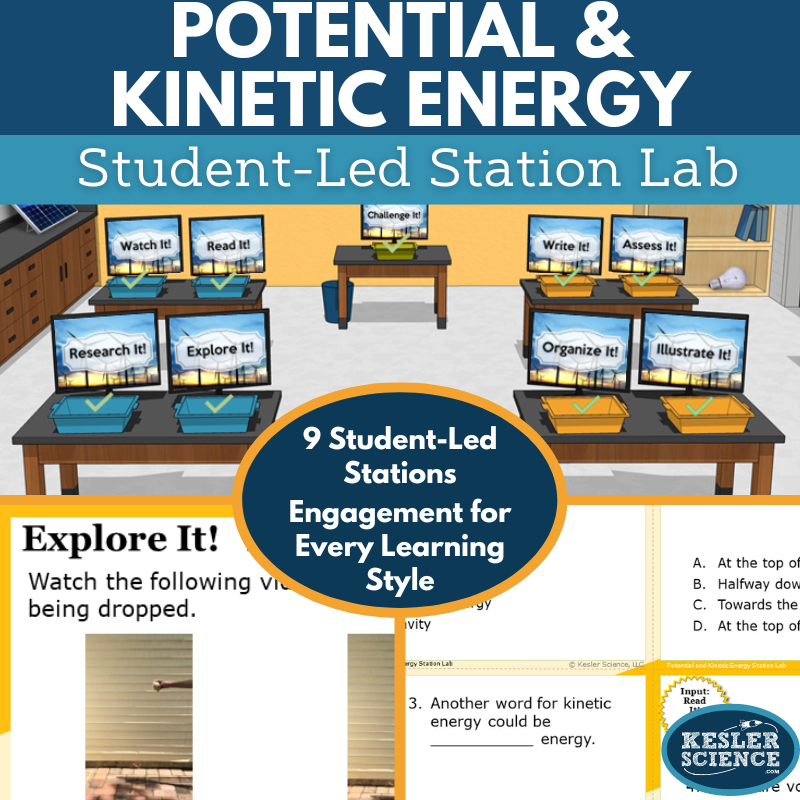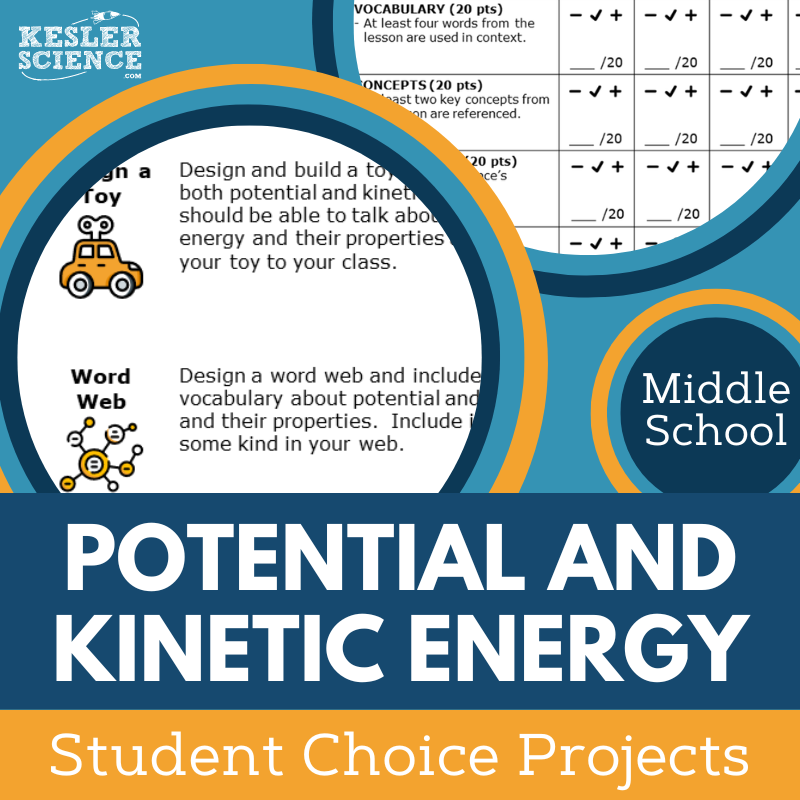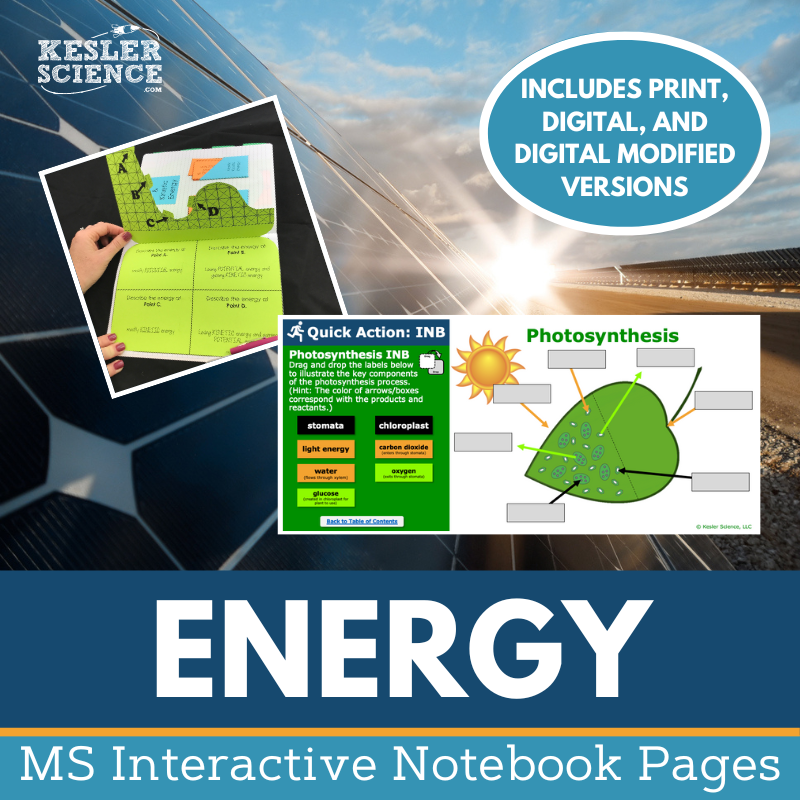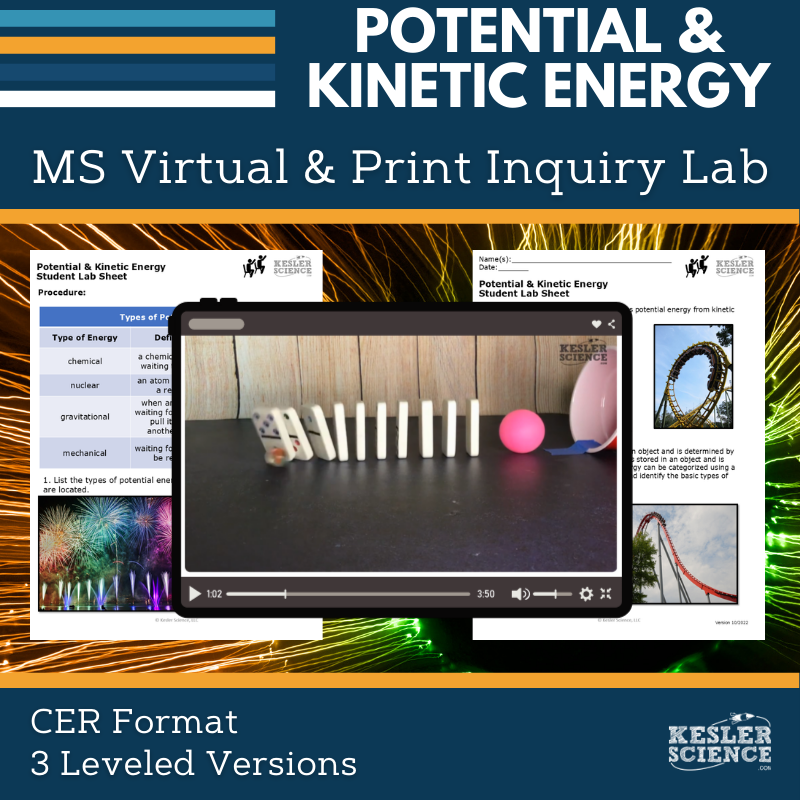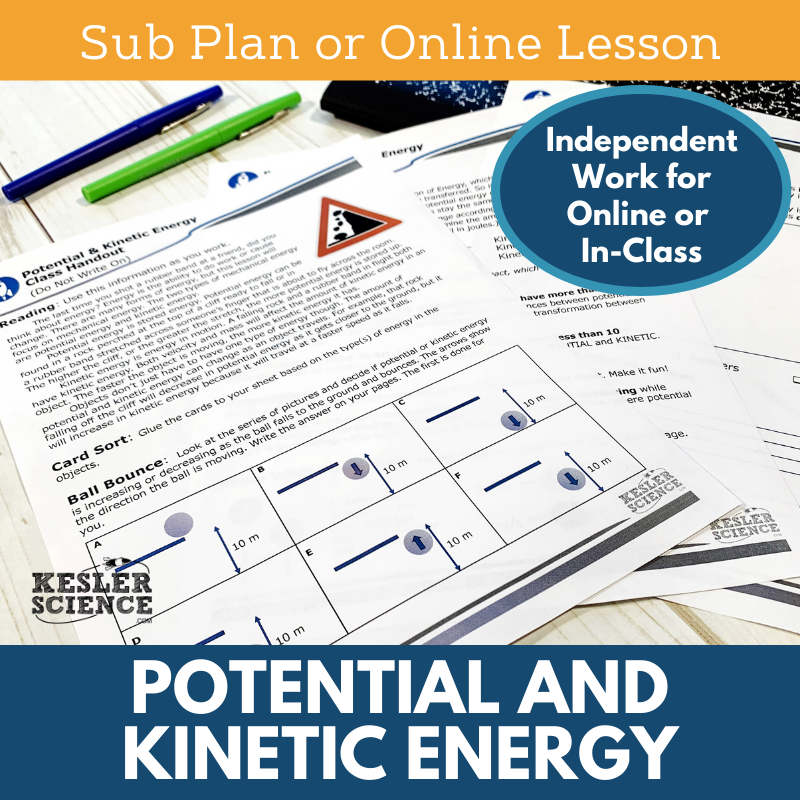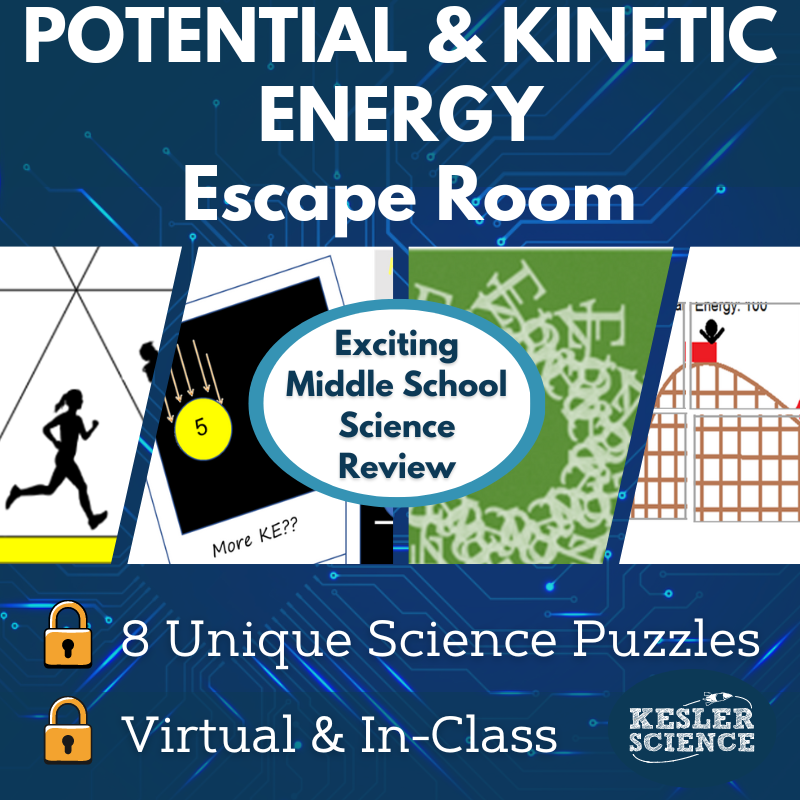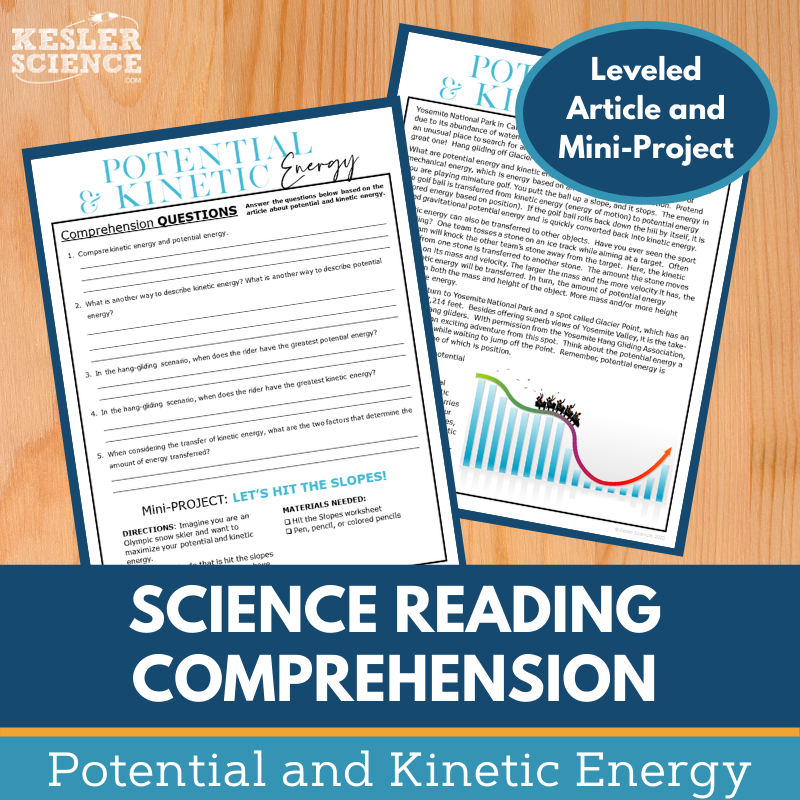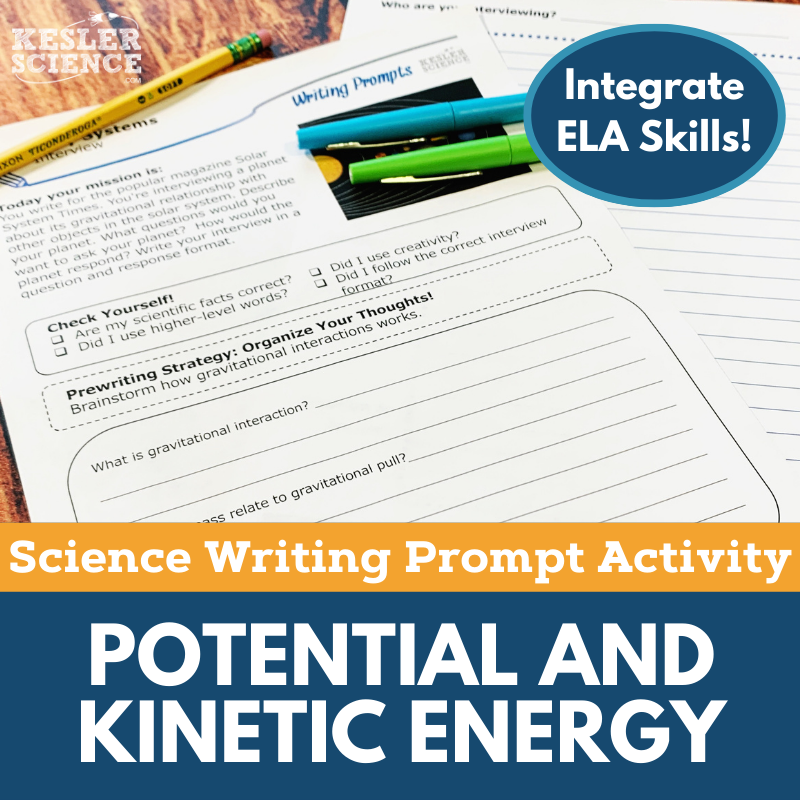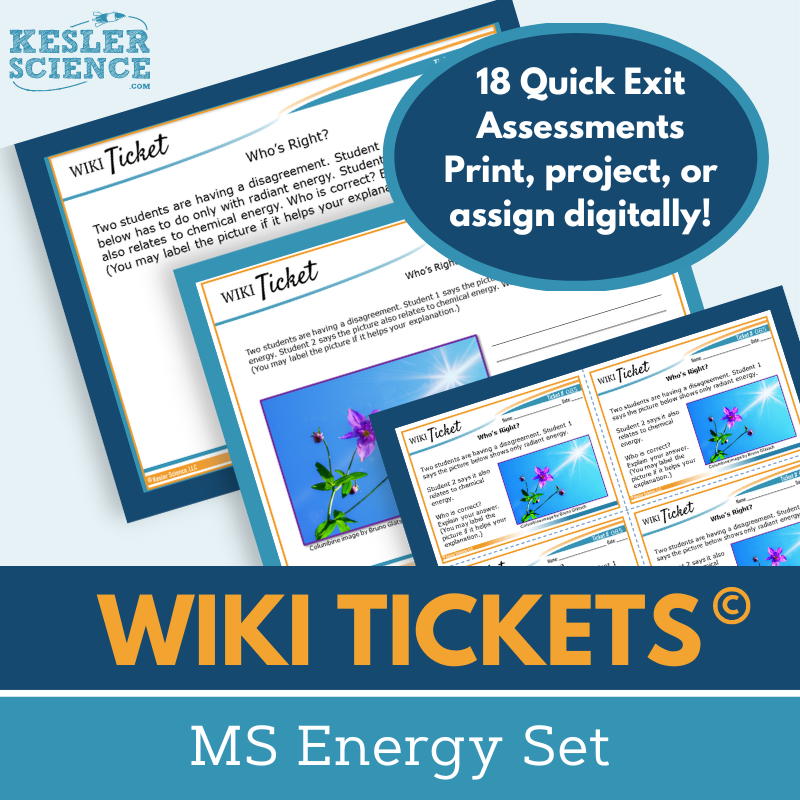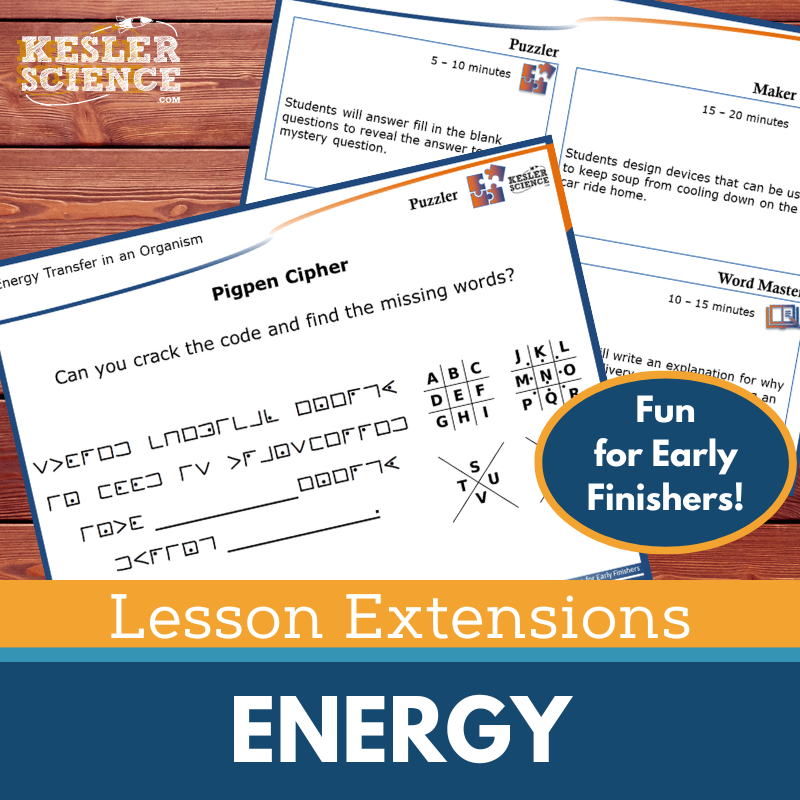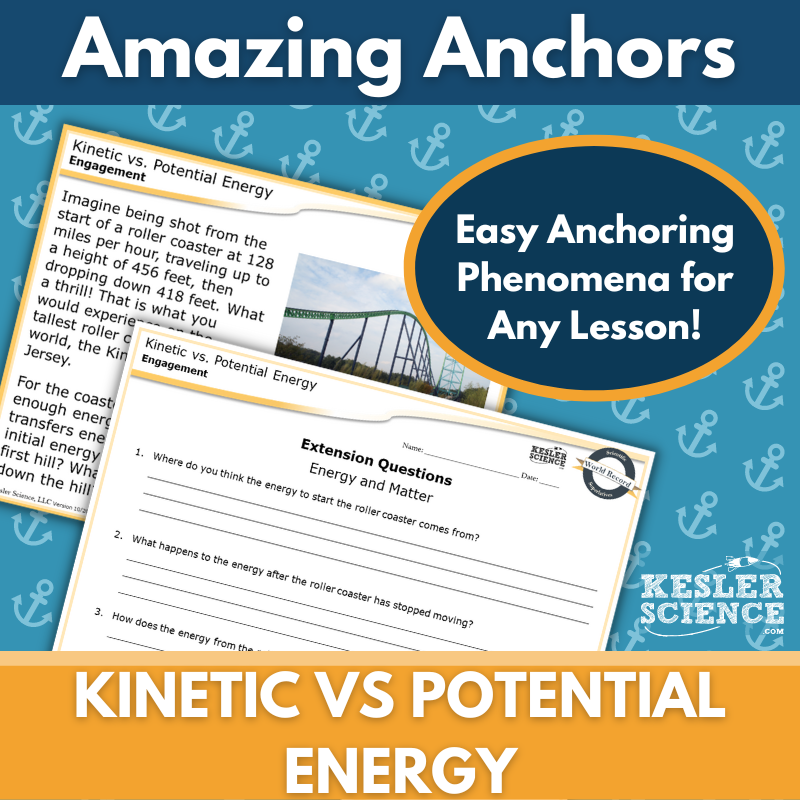Potential and Kinetic Energy Activities for Middle School Science
The Kesler Science Potential and Kinetic Energy resources offer a comprehensive, student-centered approach to teaching energy concepts, featuring differentiated materials, engaging hands-on activities, and flexible formats for both in-person and digital learning. With lesson plans, interactive notebooks, station labs, project options, and assessments available in English and Spanish, these resources provide everything needed to support middle school students in understanding and exploring the differences between potential and kinetic energy. All of the following materials are also included in the Kesler Science Membership.
The Kesler Science Potential and Kinetic Energy Complete 5E Lesson offers everything needed for a comprehensive, student-centered lesson on energy. Designed for minimal prep, the lesson follows the 5E Model: Engagement, Exploration, Explanation, Elaboration, and Evaluation, with differentiated materials to support all learners. It’s available in both printable and digital formats, and can be tailored with editable PowerPoints and resources in both English and Spanish.
In the Exploration phase, students engage with nine differentiated station labs, each designed to cater to various learning styles. These include input stations like "Explore It!" (hands-on demos) and "Read It!" (differentiated readings), as well as output stations like "Organize It!" (card sorts) and "Write It!" (open-ended responses). There’s even a "Challenge It!" station for early finishers to deepen their understanding.
The lesson includes a range of engaging materials such as word wall cards, note-taking templates, editable PowerPoints, and student-choice projects to extend learning. Evaluation tools include both formal assessments and review questions, all designed for in-person or virtual learning environments.
The Kesler Science Potential and Kinetic Energy Complete 5E Lesson offers everything needed for a comprehensive, student-centered lesson on energy. Designed for minimal prep, the lesson follows the 5E Model: Engagement, Exploration, Explanation, Elaboration, and Evaluation, with differentiated materials to support all learners. It’s available in both printable and digital formats, and can be tailored with editable PowerPoints and resources in both English and Spanish.
In the Exploration phase, students engage with nine differentiated station labs, each designed to cater to various learning styles. These include input stations like "Explore It!" (hands-on demos) and "Read It!" (differentiated readings), as well as output stations like "Organize It!" (card sorts) and "Write It!" (open-ended responses). There’s even a "Challenge It!" station for early finishers to deepen their understanding.
The lesson includes a range of engaging materials such as word wall cards, note-taking templates, editable PowerPoints, and student-choice projects to extend learning. Evaluation tools include both formal assessments and review questions, all designed for in-person or virtual learning environments.
The Kesler Science Potential and Kinetic Energy Station Lab provides an engaging, hands-on way for middle school students to explore energy concepts. With eight differentiated stations, students can direct their own learning through various activities, making the lesson both personalized and student-centered. A ninth challenge station offers extra tasks for early finishers, allowing for flexibility and enrichment.
Each station presents different learning modalities, from hands-on demonstrations in "Explore It!" to reading and research tasks in "Read It!" and "Research It!" Students can also watch videos and engage in writing or drawing activities to solidify their understanding. The station activities are designed for both in-class and virtual settings, using tools like PowerPoint or Google Slides for digital learning.
The lab promotes deeper learning through both input and output stations. From sketching models to writing short answers and assessing knowledge with task cards, students can express what they’ve learned in various formats. The materials are ready to go, saving teachers prep time while fostering independent learning.
The Kesler Science Potential and Kinetic Energy Station Lab provides an engaging, hands-on way for middle school students to explore energy concepts. With eight differentiated stations, students can direct their own learning through various activities, making the lesson both personalized and student-centered. A ninth challenge station offers extra tasks for early finishers, allowing for flexibility and enrichment.
Each station presents different learning modalities, from hands-on demonstrations in "Explore It!" to reading and research tasks in "Read It!" and "Research It!" Students can also watch videos and engage in writing or drawing activities to solidify their understanding. The station activities are designed for both in-class and virtual settings, using tools like PowerPoint or Google Slides for digital learning.
The lab promotes deeper learning through both input and output stations. From sketching models to writing short answers and assessing knowledge with task cards, students can express what they’ve learned in various formats. The materials are ready to go, saving teachers prep time while fostering independent learning.
The Kesler Science Potential and Kinetic Energy Student Choice Projects empower middle school students to select a project that aligns with their strengths and interests. With a variety of six project options plus a "design your own" choice, students can explore energy concepts in a way that suits their learning style. Teachers can assess using an editable rubric, which allows for flexibility and peer or self-assessment.
The projects offer flexibility for diverse learners, with a modified version that targets remediation and differentiation for students who need extra support. Students seeking a challenge can combine project options while using the same rubric for evaluation, making this a versatile tool for varied educational needs.
These hands-on projects require basic classroom supplies such as paper, markers, and scissors, and many can be adapted for digital completion. Teachers are supported with clear directions and suggestions, ensuring the projects are easy to implement in the classroom.
The Kesler Science Potential and Kinetic Energy Student Choice Projects empower middle school students to select a project that aligns with their strengths and interests. With a variety of six project options plus a "design your own" choice, students can explore energy concepts in a way that suits their learning style. Teachers can assess using an editable rubric, which allows for flexibility and peer or self-assessment.
The projects offer flexibility for diverse learners, with a modified version that targets remediation and differentiation for students who need extra support. Students seeking a challenge can combine project options while using the same rubric for evaluation, making this a versatile tool for varied educational needs.
These hands-on projects require basic classroom supplies such as paper, markers, and scissors, and many can be adapted for digital completion. Teachers are supported with clear directions and suggestions, ensuring the projects are easy to implement in the classroom.
The Kesler Science Energy Interactive Notebook Bundle offers an engaging way to teach energy concepts with both print and digital options. It’s perfect for traditional classrooms, 1:1 environments, or distance learning, providing flexibility for teachers and students alike.
Topics include conduction, convection, and radiation, energy transformations, renewable and nonrenewable resources, photosynthesis, potential and kinetic energy, and more. The digital version features a unique interactive notebook PowerPoint, compatibility with Google Slides, reflection pages, teacher answer keys, and a modified version for accommodations. The paper version includes blank templates, pre-filled templates for modified needs, and visual guides for assembly.
This bundle ensures students can actively participate in learning energy concepts while offering teachers versatile tools for instruction and assessment in any learning environment.
The Kesler Science Energy Interactive Notebook Bundle offers an engaging way to teach energy concepts with both print and digital options. It’s perfect for traditional classrooms, 1:1 environments, or distance learning, providing flexibility for teachers and students alike.
Topics include conduction, convection, and radiation, energy transformations, renewable and nonrenewable resources, photosynthesis, potential and kinetic energy, and more. The digital version features a unique interactive notebook PowerPoint, compatibility with Google Slides, reflection pages, teacher answer keys, and a modified version for accommodations. The paper version includes blank templates, pre-filled templates for modified needs, and visual guides for assembly.
This bundle ensures students can actively participate in learning energy concepts while offering teachers versatile tools for instruction and assessment in any learning environment.
The Kesler Science Potential and Kinetic Energy Inquiry Lab aligns with NGSS by helping students differentiate between types of potential and kinetic energy through engaging, hands-on and virtual activities. Students begin by identifying types of energy in photographs and progress to constructing a simple Rube Goldberg machine, analyzing where different forms of energy are present during each step. A guiding essential question—"What differentiates potential energy from kinetic energy?"—grounds their exploration.
This lab offers maximum flexibility with both printable and digital versions, each including comprehension questions, Claim-Evidence-Reasoning (C.E.R.) prompts, and reflection activities. A pre-recorded video demonstration is included in the digital format, making it ideal for absent students or classes without access to materials. Differentiation is built in with three levels: Modified, Dependent, and Independent, allowing teachers to choose the appropriate version for each student.
Standard classroom supplies like a marble, ping pong ball, and dominos make the print lab easy to implement. Editable files are compatible with Google Slides and PowerPoint, and teacher resources include answer keys, setup directions, standards, and objectives. The combination of multimodal learning, structured scaffolding, and flexible delivery ensures students stay engaged while developing a deeper understanding of energy transformations.
The Kesler Science Potential and Kinetic Energy Inquiry Lab aligns with NGSS by helping students differentiate between types of potential and kinetic energy through engaging, hands-on and virtual activities. Students begin by identifying types of energy in photographs and progress to constructing a simple Rube Goldberg machine, analyzing where different forms of energy are present during each step. A guiding essential question—"What differentiates potential energy from kinetic energy?"—grounds their exploration.
This lab offers maximum flexibility with both printable and digital versions, each including comprehension questions, Claim-Evidence-Reasoning (C.E.R.) prompts, and reflection activities. A pre-recorded video demonstration is included in the digital format, making it ideal for absent students or classes without access to materials. Differentiation is built in with three levels: Modified, Dependent, and Independent, allowing teachers to choose the appropriate version for each student.
Standard classroom supplies like a marble, ping pong ball, and dominos make the print lab easy to implement. Editable files are compatible with Google Slides and PowerPoint, and teacher resources include answer keys, setup directions, standards, and objectives. The combination of multimodal learning, structured scaffolding, and flexible delivery ensures students stay engaged while developing a deeper understanding of energy transformations.
The Kesler Science Potential and Kinetic Energy Sub Plan guides students through a comprehensive lesson, including a warm-up activity, a reading passage, categorization of energy types, and calculations of potential energy. The lesson also offers extension activities, such as writing a song or an acrostic poem, for early finishers.
The sub plans include all necessary support, from detailed directions for substitutes to a Google Form answer sheet for distance learning. There are also engaging activities, summative assessments, and extension options, making it a flexible resource for both in-person and remote learning environments.
Designed with substitutes in mind, these plans provide clear expectations, behavior check-points, and student PDFs for LMS use. The materials can be used in various settings, from substitute teaching to homework or small group work, ensuring that learning continues smoothly regardless of the situation.
The Kesler Science Potential and Kinetic Energy Sub Plan guides students through a comprehensive lesson, including a warm-up activity, a reading passage, categorization of energy types, and calculations of potential energy. The lesson also offers extension activities, such as writing a song or an acrostic poem, for early finishers.
The sub plans include all necessary support, from detailed directions for substitutes to a Google Form answer sheet for distance learning. There are also engaging activities, summative assessments, and extension options, making it a flexible resource for both in-person and remote learning environments.
Designed with substitutes in mind, these plans provide clear expectations, behavior check-points, and student PDFs for LMS use. The materials can be used in various settings, from substitute teaching to homework or small group work, ensuring that learning continues smoothly regardless of the situation.
The Kesler Science Potential and Kinetic Energy Escape Room offers an exciting way for students to demonstrate their understanding of energy concepts. Teachers have full control over which of the eight independent puzzles to use and the order in which they appear, making it adaptable to different class lengths.
The escape room can be set up in two ways: a budget-friendly option using manila envelopes or a more immersive experience with locks and a storage box. For online learning, there's a digital version available as a PowerPoint or Google Slides, where students work through puzzles digitally.
This product includes comprehensive teacher directions, detailed answer keys, a video challenge, printable materials, and even a list of prize ideas. It also offers an editable teacher version, a digital answer sheet, and reward templates to make the experience both engaging and flexible.
The Kesler Science Potential and Kinetic Energy Escape Room offers an exciting way for students to demonstrate their understanding of energy concepts. Teachers have full control over which of the eight independent puzzles to use and the order in which they appear, making it adaptable to different class lengths.
The escape room can be set up in two ways: a budget-friendly option using manila envelopes or a more immersive experience with locks and a storage box. For online learning, there's a digital version available as a PowerPoint or Google Slides, where students work through puzzles digitally.
This product includes comprehensive teacher directions, detailed answer keys, a video challenge, printable materials, and even a list of prize ideas. It also offers an editable teacher version, a digital answer sheet, and reward templates to make the experience both engaging and flexible.
This Potential and Kinetic Energy Science Reading Comprehension Lesson helps middle school students explore the differences between potential and kinetic energy. Students begin by reading a leveled nonfiction article about energy types, then answer comprehension questions and complete a diagram illustrating the energy transformations experienced by a skier.
Designed to support science literacy and reading comprehension, the resource includes two Lexile-leveled passages (1100–1300), 5–7 comprehension questions, a hands-on mini-project, and a Cornell notes template. Colorful graphics enhance engagement, and materials are printable in grayscale. The reading activity encourages critical thinking and allows students to practice labeling, modeling, and interpreting science content.
Ideal for classroom use, sub plans, or distance learning, the resource is compatible with Google Classroom, Schoology, MS Teams, and Canvas. Students can type directly in the editable slides, making it easy to use in both virtual and in-person settings. The reading passage also supports class discussions and routine science literacy instruction.
This Potential and Kinetic Energy Science Reading Comprehension Lesson helps middle school students explore the differences between potential and kinetic energy. Students begin by reading a leveled nonfiction article about energy types, then answer comprehension questions and complete a diagram illustrating the energy transformations experienced by a skier.
Designed to support science literacy and reading comprehension, the resource includes two Lexile-leveled passages (1100–1300), 5–7 comprehension questions, a hands-on mini-project, and a Cornell notes template. Colorful graphics enhance engagement, and materials are printable in grayscale. The reading activity encourages critical thinking and allows students to practice labeling, modeling, and interpreting science content.
Ideal for classroom use, sub plans, or distance learning, the resource is compatible with Google Classroom, Schoology, MS Teams, and Canvas. Students can type directly in the editable slides, making it easy to use in both virtual and in-person settings. The reading passage also supports class discussions and routine science literacy instruction.
The Kesler Science Potential and Kinetic Energy Writing Prompt Activity encourages middle school students to demonstrate their understanding of physical science in a fun and creative way. Using a song as the prompt, this activity sparks imagination while allowing students to explore and deepen their scientific reasoning. Whether in-class or remote, the materials are designed for flexibility, ensuring students stay engaged outside of traditional settings.
This low-prep, high-quality writing activity can be used for review or as an extension activity with other Kesler resources. Included are teacher directions with a rubric, full-sized handouts for printing, and a digital version compatible with Google Slides. Students can complete the activity in multiple formats—physical or digital—making it versatile for various learning environments.
The writing prompt is ideal for cross-curricular use, formative assessments, student choice projects, and extra credit. It's also perfect for early finishers, make-up work, or TELPAS samples, offering opportunities for differentiation and individualized learning.
The Kesler Science Potential and Kinetic Energy Writing Prompt Activity encourages middle school students to demonstrate their understanding of physical science in a fun and creative way. Using a song as the prompt, this activity sparks imagination while allowing students to explore and deepen their scientific reasoning. Whether in-class or remote, the materials are designed for flexibility, ensuring students stay engaged outside of traditional settings.
This low-prep, high-quality writing activity can be used for review or as an extension activity with other Kesler resources. Included are teacher directions with a rubric, full-sized handouts for printing, and a digital version compatible with Google Slides. Students can complete the activity in multiple formats—physical or digital—making it versatile for various learning environments.
The writing prompt is ideal for cross-curricular use, formative assessments, student choice projects, and extra credit. It's also perfect for early finishers, make-up work, or TELPAS samples, offering opportunities for differentiation and individualized learning.
The Kesler Science Energy WIKI Tickets provide flexible, formative assessments for 6th-8th grade science topics in a fun and engaging format. This set includes 18 assessments, each aligned to NGSS and TEKS standards, covering topics like energy transformations, thermal energy transfer, wave characteristics, and more. WIKI Tickets can be used in various formats, including projection, printable handouts, and interactive digital versions for virtual or in-person learning.
Each topic offers five formats: full-screen projection, full-, half-, and quarter-page handouts, and editable PPT or Google Slides files for digital use. A bonus table of contents aligns each ticket to specific standards, ensuring comprehensive coverage. These assessments are perfect for exit tickets, bellringers, or gauging student understanding throughout a lesson.
"WIKI" stands for "What I Know Is," emphasizing student reflection and learning. Whether used in a traditional classroom or remote setting, these colorful and versatile assessments help you monitor progress effectively while keeping students engaged.
The Kesler Science Energy WIKI Tickets provide flexible, formative assessments for 6th-8th grade science topics in a fun and engaging format. This set includes 18 assessments, each aligned to NGSS and TEKS standards, covering topics like energy transformations, thermal energy transfer, wave characteristics, and more. WIKI Tickets can be used in various formats, including projection, printable handouts, and interactive digital versions for virtual or in-person learning.
Each topic offers five formats: full-screen projection, full-, half-, and quarter-page handouts, and editable PPT or Google Slides files for digital use. A bonus table of contents aligns each ticket to specific standards, ensuring comprehensive coverage. These assessments are perfect for exit tickets, bellringers, or gauging student understanding throughout a lesson.
"WIKI" stands for "What I Know Is," emphasizing student reflection and learning. Whether used in a traditional classroom or remote setting, these colorful and versatile assessments help you monitor progress effectively while keeping students engaged.
The Kesler Science Energy Lesson Extensions provide engaging, student-choice activities designed for early finishers or as a wrap-up to energy lessons. These extensions offer rigorous, fun opportunities for critical thinking and creativity while aligning with NGSS and TEKS energy standards.
Each Lesson Extension includes four activities: Puzzler for problem-solving, Maker Space for hands-on STEAM projects, Tech Connection for digital media integration, and Word Master for creative writing. Resources include teacher directions, answer keys, digital projection versions, and printable handouts.
Topics covered range from kinetic and potential energy to photosynthesis, thermal energy, and more. These versatile activities scaffold learning and engage students in deeper exploration of energy concepts, making them perfect for independent learners and classroom enrichment.
The Kesler Science Energy Lesson Extensions provide engaging, student-choice activities designed for early finishers or as a wrap-up to energy lessons. These extensions offer rigorous, fun opportunities for critical thinking and creativity while aligning with NGSS and TEKS energy standards.
Each Lesson Extension includes four activities: Puzzler for problem-solving, Maker Space for hands-on STEAM projects, Tech Connection for digital media integration, and Word Master for creative writing. Resources include teacher directions, answer keys, digital projection versions, and printable handouts.
Topics covered range from kinetic and potential energy to photosynthesis, thermal energy, and more. These versatile activities scaffold learning and engage students in deeper exploration of energy concepts, making them perfect for independent learners and classroom enrichment.
The Amazing Anchors Phenomenon Lesson introduces and reinforces kinetic and potential energy through real-world connections. It begins with an engaging reading on the Kingda Ka rollercoaster, paired with comprehension and extension questions to spark curiosity. A follow-up explanatory reading breaks down the science behind energy types, helping students deepen their understanding.
This no-prep, TEKS-aligned resource includes teacher directions, answer keys, and additional support materials. It is available in both print and digital formats, with editable PowerPoints, full- and half-sheet handouts, and projection slides to fit any classroom setup. The lesson is designed to supplement instruction and works well in the Engagement and Elaborate phases of the 5E model.
Differentiation is built in with two versions of the reading: a standard version and a modified one that supports students with sentence starters and simplified language. Whether used in-person or online, this flexible resource makes it easy to connect science concepts to students’ real-world experiences.
The Amazing Anchors Phenomenon Lesson introduces and reinforces kinetic and potential energy through real-world connections. It begins with an engaging reading on the Kingda Ka rollercoaster, paired with comprehension and extension questions to spark curiosity. A follow-up explanatory reading breaks down the science behind energy types, helping students deepen their understanding.
This no-prep, TEKS-aligned resource includes teacher directions, answer keys, and additional support materials. It is available in both print and digital formats, with editable PowerPoints, full- and half-sheet handouts, and projection slides to fit any classroom setup. The lesson is designed to supplement instruction and works well in the Engagement and Elaborate phases of the 5E model.
Differentiation is built in with two versions of the reading: a standard version and a modified one that supports students with sentence starters and simplified language. Whether used in-person or online, this flexible resource makes it easy to connect science concepts to students’ real-world experiences.
Year-Round Resources
These year-round activities will increase your students' understanding of many middle school science topics. All of these activities are also included in the Kesler Science Membership.
Visual Data & Graphing
You're not alone if your students struggle with understanding graphs, charts, and tables. It's a skill that takes an enormous amount of practice. This resource will help students build a strong foundation in analyzing data and creating their own data visualizations.
Bell Ringers and Warm-Ups
These middle school science bell ringers are an excellent way to engage your students as soon as they walk into your classroom. This comprehensive FULL YEAR resource includes everything you need to start off each science class with an interesting warm-up activity.
Review Board Games
Each game board has been carefully designed to keep students engaged. There are 10 different action spaces on each board and dozens of question cards. All of the actions are related to science concepts and keep the students motivated throughout the game.
Each game is ready to play. Simply print out the board and the cards and let the students enjoy reviewing nine different units.
Essential Questions
Below are the essential questions associated with the lessons and activities included in this unit. This topic is only one of more than 100 middle school science topics included in the Kesler Science Membership.
-
Compare and contrast potential and kinetic energy.
Kesler Science Membership
Imagine never having to search for another middle school science lesson again. The membership gives you access to ALL of the Kesler Science products in one place (Yes, including everything above).
Say goodbye to long hours of lesson prep.

